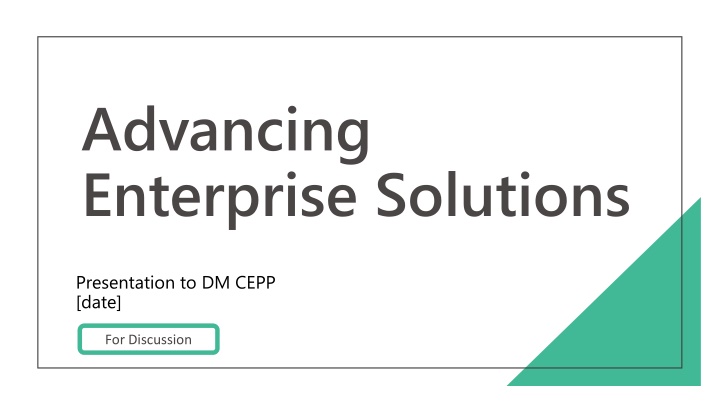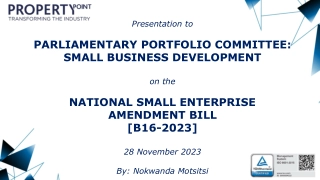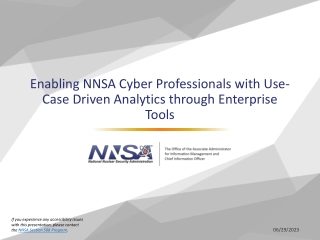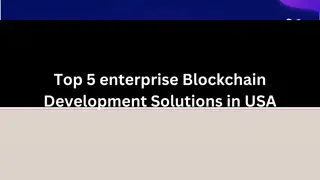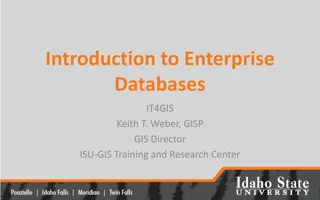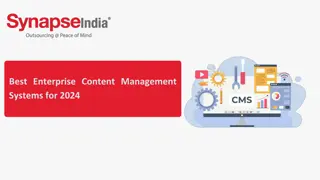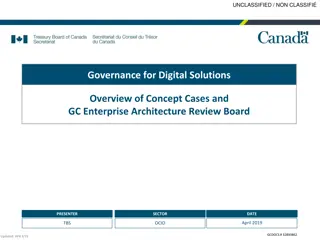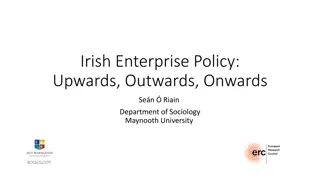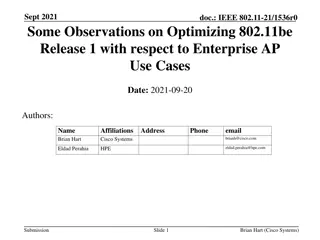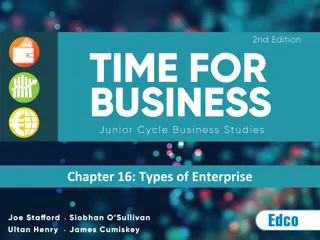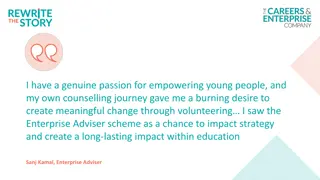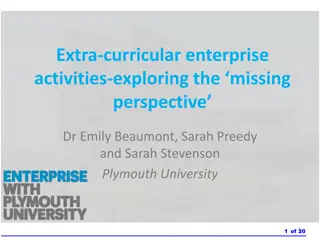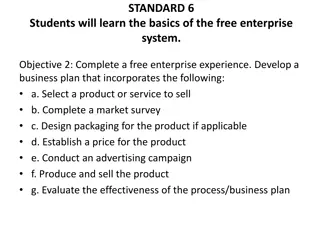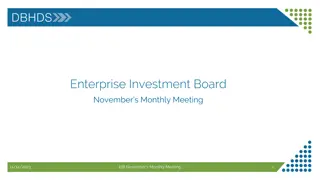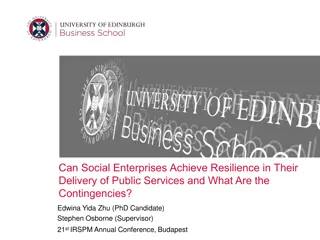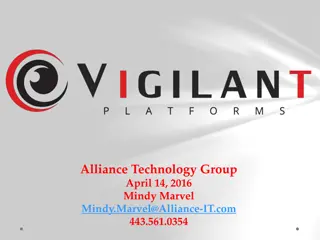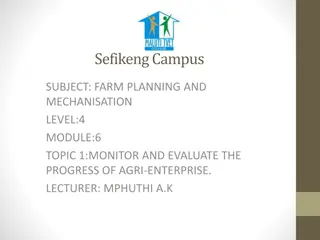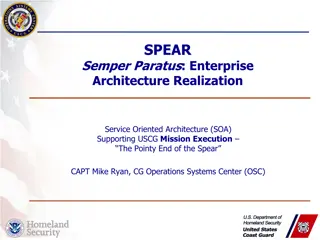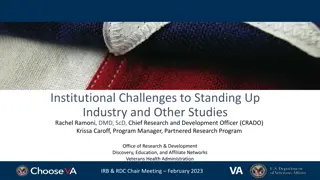Advancing Enterprise Solutions Presentation for Discussion
This presentation focuses on advancing enterprise solutions within the Government of Canada, particularly in the context of whole-of-government approaches and digital transformation. It discusses the importance of a holistic enterprise approach, governance solutions, and how enterprise is addressed at various levels within the organization. The emphasis is on utilizing shared IT solutions, assets, and services to avoid duplication, adopting enterprise solutions at the departmental level, and aligning with the enterprise-wide plan set by the CIO of Canada. Additionally, the presentation highlights the significance of focusing on enterprise solutions linked to business capabilities to operate effectively and advance the CEPP mandate.
Download Presentation

Please find below an Image/Link to download the presentation.
The content on the website is provided AS IS for your information and personal use only. It may not be sold, licensed, or shared on other websites without obtaining consent from the author.If you encounter any issues during the download, it is possible that the publisher has removed the file from their server.
You are allowed to download the files provided on this website for personal or commercial use, subject to the condition that they are used lawfully. All files are the property of their respective owners.
The content on the website is provided AS IS for your information and personal use only. It may not be sold, licensed, or shared on other websites without obtaining consent from the author.
E N D
Presentation Transcript
UNCLASSIFIED / NON CLASSIFI Advancing Enterprise Solutions Presentation to DM CEPP [date] For Discussion 1 TBS - OCIO
UNCLASSIFIED / NON CLASSIFI What is enterprise? Enterprise is generally defined as an organization or organizational unit GOVERNANCE SOLUTIONS In the GC, enterprise refers to a whole-of- government holistic approach. CULTURE An enterprise approach can be applied various facets, like governance, solutions, standards and culture 2 TBS - OCIO
UNCLASSIFIED / NON CLASSIFI How is enterprise addressed in the GC?* CIO of Canada Providing direction on the enterprise-wide transition to digital government Approving an annual, forward-looking three- year enterprise-wide plan that establishes the strategic direction for the integrated management of service, information, data, IT, and cyber security (i.e., Digital Operations Strategic Plan) Setting direction and expectations in enterprise architecture technology, and information and data standards for quality, accessibility, and data interoperability Deputy Heads: Approving an annual forward-looking three- year departmental plan [aligned] with the CIO of Canada s enterprise-wide integrated plan . Using enterprise or shared IT solutions, assets, and services to avoid duplication, when available and appropriate Departmental CIOs: Adopting, as applicable, enterprise solutions within their respective department. Participating, as a service provider or as a service client, in the conception, planning, evolution and oversight of enterprise-wide IT services and solutions. * TB Policy on Service and Digital ; TB Directive on Service and Digital 3 TBS - OCIO
UNCLASSIFIED / NON CLASSIFI Why focus on enterprise solutions? To operate as one and advance the CEPP mandate we propose to focus on enterprise solutions linked to business capabilities Enterprise solutions are internal and external Government of Canada assets that can be re-used in and across multiple parts of the organization. Business capabilitiesare an expression of what a business does and can do. Business processes support business capabilities and express how the capability is delivered. 4 TBS - OCIO
UNCLASSIFIED / NON CLASSIFI Enterprise Back-Office Applications* PSC TBS PSPC Jobs.gc.ca Financial management transformation GCTools Project & portfolio management (IT Plan, APM, IT expenditures, Project Oversight, Business Services) Callipers Executive Talent Management System Public Service Performance Management TBS Application Portal GC Interoperability Platform Enterprise Grants & Contributions System Wellness Productivity System Identity Credential and Access Management System Credential Broker Services Internal Credential Management Open Government Portal Access to Information Portal Talent Cloud GCDOCS Shared Case Management BuyandSell.ca Termium eProcurement Solution National Service Call Centre WebEx Shared Travel Services Phoenix myGCHR Compensation Web Apps ESDC Canada.ca SSC Email GCSRA GCSI GEDS GCKey CSPS Integrated Learning Management System / Gccampus * Non-exhaustive list - http://www.gcpedia.gc.ca/wiki/List_of_Enterprise_Applications 5 TBS - OCIO
UNCLASSIFIED / NON CLASSIFI What are the roles and responsibilities and who decides who fills them? What is the financial and funding model for an enterprise solution? Which businesscapabilities should be addressed first? How will user expectations be addressed? What is the path to enterprise-wide adoption? Whatis needed for Enterprise Solutions to work in the GC? GOVERNANCE SOLUTIONS Is everyone ready to buy-in to enterprise solutions? How do we ensure participation? How will open and transparent input be gathered? What are the mind-set and skills needed to foster an enterprise solution culture? CULTURE Which business problem are we solving? Who can access the Enterprise Solution? What data and technology standards are required? Is the implementation secure enough? Will it always be reliably online? 6 TBS - OCIO
UNCLASSIFIED / NON CLASSIFI Who decides what becomes an enterprise solution? DM CEPP has the mandate to establish and govern the direction and priorities for modern GC enterprise solutions DM CEPP will: Establish priorities and standards to be used by the Enterprise Architecture Review Board Review and endorse prioritization of core systems for modernization Establish priorities for IT shared services and assets, and enterprise-wide IT investments and procurements 7 TBS - OCIO
UNCLASSIFIED / NON CLASSIFI How can enterprise solutions be used? Different models are appropriate for different situations: Minimal / no value added having more than one choice Frees up your resources to focus only your business needs Successful when scope is very tight Ownership: Consistent Operation: Consistent User Experience: Consistent Capabilities: Consistent Current GC Example: PSPM Real World Example: Windows patching Star Repeatable, trusted processes Allows for local instances, but can harness the power of the collective Can be clustered for even greater efficiency Ownership: Varies Operation: Varies User Experience: Consistent Capabilities: Consistent Current GC Example: MS Teams Real World Example: McDonald s Franchise Reusable, loosely coupled systems Share reusable artifacts for key functionality Allows for flexibility and autonomy in delivery Ownership: Varies Operation: Varies User Experience: Varies Capabilities: Consistent Current GC Example: GCDOCs Real World Example: Uber Eats Federated 8 TBS - OCIO
UNCLASSIFIED / NON CLASSIFI A more cohesive digital experience for clients, users and other stakeholders Increased interoperability and collaboration between government services and programs What are the benefits to this approach? Reduced total cost of ownership for provision external and internal services Ability to leverage modern skill sets across the Government of Canada Operate as one, to better serve all 9 TBS - OCIO
UNCLASSIFIED / NON CLASSIFI What do we have today? GC Business Capability Model* GC EARB Decision Framework** * see Annex A ** see Annex B Provides a structured view of what the enterprise does with multiple levels of granularity. When more than one department have a need for a common business capability there is an opportunity for an Enterprise Solution. Defines decision framework for alignment of solutions to enterprise direction and standards Clarifies how and when to adopt an enterprise solution Helps align investments in digital initiatives that address similar business capabilities 10 TBS - OCIO
UNCLASSIFIED / NON CLASSIFI Opportunities Business Capability: Audit Management (9.6) Current status: Audit management software in use by ~1,000 users in over 35 large departments / organizations across the GC. TBS Office of the Comptroller General s (OCG) Internal Audit Sector has proposed a single GC enterprise solution using TeamMate+(TM+) to improve cross-departmental audits functionality and data sharing TBS OCG would fill the role of Business Owner. An IT organization is required to fill the role of Service Provider (i.e., implement and operate the system) If no action is taken: 35 separate instances of TM+ software will be implemented, increasing the size and risk of the GC s application portfolio. Business Capability: Training and Development Management (8.3.4) CSPS has proposed a Digital Learning and Development Platform for GC employees. CSPS is the Business Owner. There are 3 options: 1. Single shared solution (i.e., star ) 2. Departmental schools on common shared solution (i.e., federated ) 3. Separate solutions for each department s internal requirements -- increasing the size and risk of the GC s application portfolio. 11 TBS - OCIO
UNCLASSIFIED / NON CLASSIFI What does the future look like? GC Enterprise Architecture Target State Defines a whole-of-government approach for the digital enablement of services Aligned to business services and based on re-useable components linked to business capabilities Focus on users and service delivery Reduces the silos and unnecessary redundancy within the current GC ecosystem 12 TBS - OCIO
UNCLASSIFIED / NON CLASSIFI 1. Establish priority business capabilities with potential for high-value enterprise solutions (e.g., identity management, audit management) What do we do next? 2. Define business owner role and designate departments to lead discovery-phase for select enterprise solutions under oversight of DM CEPP and GC EARB. 3. Build a roadmap for DM CEPP enterprise solutions to establish prioritization of enterprise-wide IT investments and procurements 13 TBS - OCIO
UNCLASSIFIED / NON CLASSIFI ANNEXES 14 TBS - OCIO
UNCLASSIFIED / NON CLASSIFI Annex A: GC Business Capability Model v2.0 15 TBS - OCIO SOURCE: GCBCM_GCMCA_v2_VisualModel_20190617_EN.pdf (gcconnex.gc.ca)
UNCLASSIFIED / NON CLASSIFI Annex B: GC EARB Decision Making Framework 16 TBS - OCIO
UNCLASSIFIED / NON CLASSIFI Annex C: GC Enterprise Architecture Target State 17 TBS - OCIO
